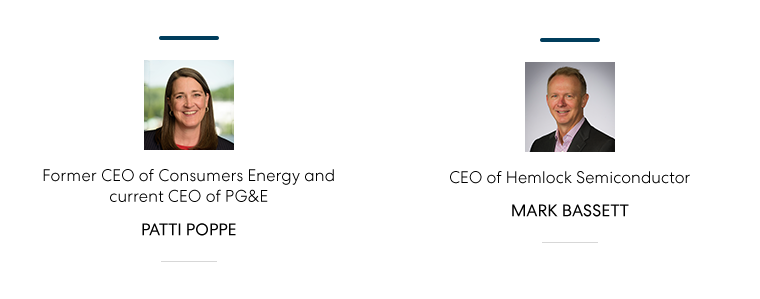
Article
A Bold Vision to Save the Lives of 475,000 Americans Each Year
March 11, 2020
DatePublished: 03-11-2020 03:12:03
DateModified: 10-23-2023 04:59:39
Read More
Article

February 15, 2021
DatePublished: 02-15-2021 09:40:29
DateModified: 10-23-2023 04:59:40

In Michigan, Consumers Energy and Hemlock Semiconductor Corporation had been long-time adversaries, despite HSC being Consumers’ largest customer. The relationship reached a breaking point when, in order to survive, HSC needed an energy rate cut beyond what Consumers could legally provide. Rather than accepting the scenario for what it appeared to be—a sad but unavoidable loss for both organizations—two new, visionary CEOs built a breakthrough environment based on mutual affinity. The result was both an extraordinary partnership and outcomes with global implications that neither organization could have imagined.
The stakes couldn’t have been higher, and the feud couldn’t have been more complex. In 2016, Hemlock Semiconductor Corporation in Mid-Michigan faced an existential crisis. They had to cut costs or, potentially, go out of business. Their largest expense was energy. Reducing it would require striking a complicated, longshot-deal with Michigan-based utility Consumers Energy. The problem? Not only was Consumers legally constrained from giving HSC a special deal, but they weren’t particularly inclined to: HSC and Consumers had been feuding for 20 years. The animosity toward each organization was institutionally entrenched in the other.
“Inside Hemlock, the mindset was, ‘They’ve got a monopoly, so they don’t have to do anything,’” says Mark Bassett, CEO of Hemlock Semiconductor, a leading manufacturer of polycrystalline silicon and semiconductor chemicals for the semiconductor and solar industries. “‘They’ve never been willing to work with us; they’ve never been willing to be creative. Why would we even consider trying to work with them?’”
The likely solution was already visualized. HSC would leave Consumers and build their own on-site power plant. It would cost HSC $400 to $500 million—not exactly an ideal path to cost-saving. The plan had plenty of downsides for Consumers, too. HSC was their largest customer. And amidst a global transition to clean energy, Michigan’s grid didn’t need a new power plant. Though it made them unique in their industry, Consumers had made a meaningful commitment to—and investment in—decarbonizing.
“To build a dedicated gas power plant for Hemlock would have truly been going in the opposite direction of our commitment to the planet,” says Patti Poppe, Former CEO of Consumers Energy, which provides natural gas and electricity to 6.6 million of Michigan’s 10 million residents.
Given the complexity of the situation, no one would have guessed that two years later, the CEOs of HSC and Consumers would be, hand-in-hand, lobbying state lawmakers to allow their partnership to move forward—or that the pair of them would chase the governor up the steps of his home to get his attention on the matter. One longtime state legislator was brought nearly to tears by the mere sight of the longtime rivals working so hard to work together.
The improbable breakthrough happened because HSC and Consumers had exactly one thing going for them: brand-new CEOs who wanted nothing to do with the decades of baggage between their organizations. Patti and Mark took the reins of their respective companies in the summer of 2016. Both knew the challenge before them was likely insurmountable. But both were committed to solving it anyway.
The transformation all began with a pointed seating choice at a meeting for Michigan business leaders. Days into her new position, Patti scanned the room and decided to sit down next to a key stakeholder who had lived this.
“I just knew it was time to change the dynamic with HSC,” says Patti, “so I leaned over to him and said, ‘I think it’s time for a truce.’ He replied, ‘You think?’” The stakeholder referred Patti to Mark. “He doesn’t have any baggage,” he told Patti.
Mark may not have personally had Consumers-related baggage, but he had plenty of challenges before him. At the time of his appointment, HSC had recently been spun off from Dow and was under tremendous pressure to cut costs. Mark was given a strategic mandate: reduce HSC’s total cost to serve by 30 percent. If he didn’t, there were serious questions as to whether the company would survive. HSC operates in a highly globalized market; most of their competitors are in China and consistently undercut them on price. HSC had to become price-competitive.
Patti’s pressures from inside Consumers were dramatic as well. Losing HSC as a customer was not an option, but, legally, neither was simply lowering their rate. She appreciated HSC’s dilemma, but those in her company who’d spent years fighting HSC and Dow on rates and other matters had less sympathy. Plus, HSC had just spent 20 years paying a discounted economic development rate, which had just expired.
“Inside Consumers Energy, there was a strong point of view that Hemlock had had their discount, and they didn’t need any more,” Patti says. “That was the language: ‘They had their 20-year discount, it’s time for them to stand on their own.’”
It was the same story for Mark when he started to dig into this issue with his people. They were frustrated and resigned that the situation would never change. He got an earful: “You know the game is rigged in their favor. They don’t have to do anything, and their earnings keep going up every year.”
It would have made sense for Hemlock to take matters into their own hands and build their own plant, and for Consumers to decline to discount the rate. Two different CEOs may have persisted in their views and supported their own people. It would have been spoken of as an issue without common ground in which the leaders did what was right for their businesses. That might have been the end of the story, but it wasn’t.

Patti and Mark were both confident they could find a win-win solution; they just had to find it. And while Patti made the first move by sitting down next to a key stakeholder, Mark independently reached out to her to see what opportunities they could create together.
“There was a huge negative vibe toward Consumers, but I took a stand of, ‘Don’t assume the worst,’” says Mark. “I felt it was much better to live through some of the growing pains of this relationship and try to hang in there to find the right solution—a better solution. My feeling was, we’ve just got to suck it up. We’ve got to give it time.”
It was the right perspective, their initial meetings weren’t fruitful. But to hear Patti tell it, Mark’s tenacity became their first moment of breakthrough.
“Without Mark’s willingness to keep the conversation going, it would have died,” she says. “We had to really grant trust. Mark and I did not know each other. We walked in cold.”
Patti was already familiar with the work of Gap International, a business consulting company that specializes in breakthrough thinking and organizational alignment. She knew that a breakthrough was needed, and that the challenge was not one of clever negotiations; but rather, the need to establish warmer authentic relationships between the leaders and then take on the challenge of bringing their companies along—no easy task. The two leaders came together, created a new possibility for their companies, and then jointly resolved to make something happen that otherwise was not remotely possible. The purposeful relationship that developed between the two of them set a powerful example for everyone in their organizations to see and emulate—even if setting that example came at an expense.
Patti and Mark were thoughtful in choosing the right leaders who they could count on to transform the current situation. Patti picked a team she called “natural breakthrough leaders” who could stay focused on the outcome of creating a partnership and solution instead of delving into how things had been. They wanted people who didn’t hold grudges and could work together to find common solutions.
Rather than telling their teams what to do and how to do it, Patti and Mark empowered them to take charge and lead, creating an environment of ownership where people naturally stepped up. It became their mission to own and deliver. The teams were excited to work together—they grabbed the reins and never looked back. They formed close personal relationships and were able to talk candidly about tough issues without hesitation because they knew they were all committed to a solution that worked for everyone.
The ability to work together in this way was enabled by Consumers’ experience working with Gap International on causing business breakthroughs. “This was DV’s breakthrough project,” Patti says of DV Rao, a Consumers Energy Senior Vice President and influential member of the team working with HSC. “We were all steeped in breakthrough thinking, and DV was the greatest, natural breakthrough leader. Breakthrough thinking was very consequential in our willingness not to leave the discussions because we knew, one way or another, we could find a path.”
The result was not only a rate agreement—one that didn’t even pass on HSC’s discounted rate to residential rate-payers—but also the financial framework Patti and her team needed to earn buy-in from other internal stakeholders at Consumers. “We were able to see that we’re saving half a billion dollars by not building [a new power plant],” she says. “That’s when people started [to see that] we’re saving money by fixing the price. And we could avoid adding more fossil fuel power generation to a grid that doesn’t need it in the midst of a clean energy transformation.”
Internal buy-in was just the beginning. Once Consumers and HSC had settled on a deal, a whole new challenge was before them: lobbying Michigan lawmakers to accept the rate change. No longer were the two organizations acting as a supplier and a customer, but rather partners working together to achieve an outcome. They met together. They lobbied together. They changed minds together. Their partnership was so transformative that simply the fact that they were both in agreement on the proposed rate change was enough to win bipartisan support in a deeply divided state legislature. The fact that their proposed legislation benefited jobs didn’t hurt, either.
Powerful Partnerships Webinar
The legislation passed. Five years after their first meeting, HSC’s rate change took effect. Patti and Mark see their breakthrough relationship as threefold: personal, professional, and global.
When they talk about their accomplishment together, they laugh about Mark’s Christmas present for Patti: a regulation sized cornhole set decked with the logos of both companies. Patti loved the gift, and also the bigger meaning, saying, “The fact that we were able to galvanize and gather and build real honest relationships—it was just magic.”
The historic deal between the organizations wasn’t the only outcome of the magic.
The solution didn’t pass cost on to the rate payers in the “balancing” that normal utility regulatory frameworks employ. Routinely, if someone receives a discount, someone else has to pay. Instead, the legislation differentiated high energy-use businesses as important for maintaining consistent load on the grid, and thus offered them discounted rates. The legislation also opened up Michigan for other high energy-use businesses such as data centers and manufacturing, which is desirable for job creation and economic development.
In addition, HSC’s solar products and Consumers’ strategy of moving away from coal plants and investing in solar and wind are, it turned out, perfectly aligned.
“When I think about the attributes of the breakthrough environment, there’s affinity, and we definitely developed affinity,” Patti says. “But we also have this purpose in mind, of getting beyond the transaction. We knew we wanted this notion of, let’s make this good for Michigan.”
And they didn’t stop there.
“We didn’t realize it at first, but in the end, we came together to save the planet,” says Patti. “Now, we’re talking about saving the world, when before we were talking about, ‘How much are you charging me?’ and, ‘Why should I give you a special break?’
“This is the true potential of our partnership, and this all happened because of the expansion of our relationship.”
When leaders take a stand and create working relationships that go beyond the problem before them, they can create more than solutions. They can create possibility. Yes, HSC and Consumers met their business objectives, against all odds. Consumers retained their largest customer without passing the costs along to residential ratepayers. HSC significantly reduced their costs. But today, their partnership is more than the sum of the solution they found together. HSC and Consumers are solving global challenges together. Their relationship is deep and purposeful. It demonstrates how utilities and their customers can lead the energy transformation together when leaders take a stand to transform their relationships and lead their organizations to a new way of operating.
A business leader doesn’t have to be the head of a public utility or chemical manufacturer in the midst of a 20-year feud to learn from Mark and Patti’s breakthrough leadership. Complex, even seemingly intractable business issues, whether they are internal or between business partners, often have the potential for an extraordinary outcome—and always through the same first step: establishing trust.
“Mark and I took a risk, there’s no doubt,” Patti says. “But we just took the end game as a reason to grant that trust. The outcome was worth changing the mindset and changing the language that we used to talk about each other—interrupting that narrative that we were enemies.”
With the courage to establish trust and the audacity to change the narrative, business leaders across any industry facing any number of challenges can work their way toward breakthrough results.
You may also Like
Your bookmark has been saved. You can view it any time by accessing 'Saved Content' in the main navigation menu.